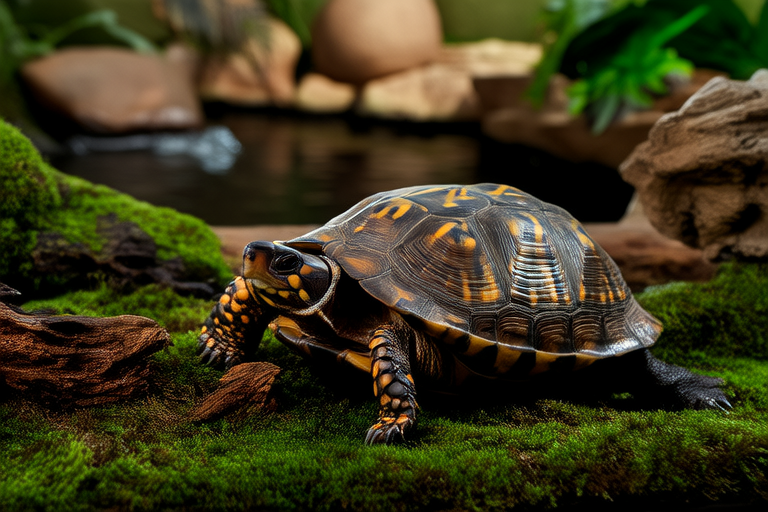Creating the Ideal Habitat for Three-Striped Box Turtles
The three-striped box turtle (Terrapene carolina triunguis) is a captivating reptile native to the central United States. These turtles are known for their distinctive three yellow stripes running down their head and neck, which give them their common name. Providing an optimal habitat is crucial for the health and longevity of these turtles. This article will guide you through the process of setting up the perfect enclosure for your three-striped box turtle, ensuring they thrive in captivity.
Enclosure Size
The first step in creating an ideal habitat for your three-striped box turtle is choosing the right enclosure size. Adult three-striped box turtles require a spacious living area that allows for ample movement and exploration. A minimum enclosure size of 4 feet by 6 feet is recommended for one adult turtle. If you plan to house multiple turtles, increase the dimensions accordingly, providing at least 10 square feet per additional turtle.
Temperature and Humidity Requirements
Maintaining the correct temperature gradient within the enclosure is vital for your turtle’s overall well-being. The enclosure should have a basking spot with a temperature range of 85°F to 90°F (29°C to 32°C). The cool side of the enclosure should remain between 75°F and 80°F (24°C to 27°C). Use a reliable thermometer to monitor these temperatures.
Humidity levels play a significant role in the health of your turtle. Three-striped box turtles thrive in a humid environment, ideally between 60% and 80%. To achieve this, mist the enclosure daily or install a humidifier. Ensure there is adequate ventilation to prevent mold growth and respiratory issues.
Suitable Substrate
Selecting the right substrate is essential for replicating the natural environment of the three-striped box turtle. A mix of organic topsoil, coconut fiber, and sphagnum moss provides a safe and comfortable surface for your turtle. This substrate combination mimics the moist, slightly acidic soil found in their natural habitat, promoting healthy skin and preventing shell deformities.
Avoid using gravel, sand, or cedar shavings as substrates, as they can cause impaction if ingested or irritate your turtle’s respiratory system. Additionally, these materials may absorb moisture, leading to fungal growth.
Necessary Lighting (UVB)
Three-striped box turtles require exposure to ultraviolet B (UVB) light to synthesize vitamin D3, which aids in calcium absorption and bone health. Install a full-spectrum UVB lamp over the basking area, ensuring it covers at least 50% of the enclosure. Replace the bulb every six months or according to the manufacturer’s instructions to maintain its effectiveness.
Provide a photoperiod of 12 hours of light and 12 hours of darkness to mimic natural day-night cycles. This schedule helps regulate your turtle’s circadian rhythms and encourages normal behavior patterns.
Water Area
Incorporating a shallow water area into the enclosure is essential for your turtle’s hydration and hygiene needs. The water depth should be no more than the height of your turtle’s shell, allowing them to easily enter and exit the pool. Change the water daily to prevent bacterial growth and ensure cleanliness.
Consider adding aquatic plants or rocks to create a more naturalistic environment. This setup also provides stimulation and enrichment for your turtle.
Hiding Spots
Providing hiding spots within the enclosure is crucial for the psychological well-being of your three-striped box turtle. Turtles often seek shelter to feel secure and reduce stress. Incorporate caves, hollow logs, or artificial hide boxes to offer multiple hiding options. Ensure these structures are stable and provide enough space for your turtle to fully extend its body.
Position the hiding spots throughout the enclosure, including both the warm and cool sides, to allow your turtle to choose its preferred temperature range while seeking refuge.
Diet Considerations Within the Habitat
Feeding your three-striped box turtle directly within the enclosure can be beneficial for several reasons. It encourages natural foraging behaviors and reduces the risk of stress associated with handling. Offer a balanced diet consisting of leafy greens, fruits, insects, and commercial turtle pellets. Place food in various locations around the enclosure to simulate natural foraging.
Ensure fresh water is always available for drinking and soaking. Monitor your turtle’s eating habits and adjust the diet as needed to maintain optimal health.
Regular Maintenance Tips
Regular maintenance is key to keeping your three-striped box turtle’s habitat clean and healthy. Perform a thorough cleaning of the enclosure weekly, removing any uneaten food, feces, and soiled substrate. Disinfect the enclosure and all accessories with a reptile-safe disinfectant, rinsing thoroughly before replacing the substrate and furnishings.
Monitor the humidity levels and adjust as necessary to maintain the ideal range. Inspect the substrate for signs of mold or decomposition, replacing it if needed. Regularly check the UVB lamp and thermometer to ensure they are functioning correctly.
Conclusion
Creating an ideal habitat for your three-striped box turtle requires careful consideration of enclosure size, temperature and humidity requirements, suitable substrate, necessary lighting, water area, hiding spots, diet considerations, and regular maintenance. By following these guidelines, you can provide a stimulating and healthy environment for your turtle, promoting optimal health and longevity. Remember to observe your turtle closely and make adjustments as needed to ensure they thrive in their new home.
